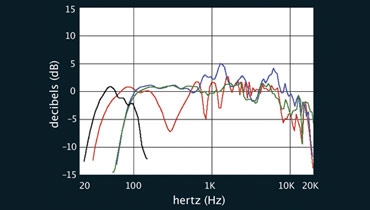JBL ES Series home theater speaker system Page 3

Test Bench
By Tom Nousaine
Frequency response (at 2 meters) • front left/right 46 Hz to 15 kHz ±7.6 dB • center 83 Hz to 14.8 kHz ±7.8 dB • surround 85 Hz to 17.8 kHz ±6.2 dB • subwoofer 34 Hz to 103 Hz ±1.9 dB
Sensitivity (SPL at 1 meter with 2.8 volts of pink-noise input) front left/right 87 dB center 92 dB surround 87 dB
Impedance (minimum/nominal) front left/right 2.8/4 ohms center 3.6/6 ohms surround 5.6/10 ohms
Bass limits (lowest frequency and maximum SPL with limit of 10% distortion at 2 meters in a large room) front left/right 40 Hz at 84 dB center 62 Hz at 63 dB surround 80 Hz at 88 dB subwoofer 25 Hz at 86 dB SPL 104 dB average SPL from25 to 62 Hz 113 dB maximum SPL at 62 Hz bandwidth uniformity 92%
All the curves in the frequency-response graph are weighted to reflect how sound arrives at a listener's ears with normal speaker placement. The curve for the left/right front channels reflects response of the ES80 with the speaker standing on the floor averaged over a ±30° window. The center-channel curve reflects response of the ES25C averaged over ±45°, with double weight directly on-axis of the primary listener. The surround-channel curve shows the response of the ES10 averaged over ±60°.
Because the ES80 will always be used on a floor all measurements were taken with the speaker on a carpeted floor. Both the center and surround channel speakers were measured on a 6-foot stand, which gives anechoic results to approximately 200 Hz. All upper channel measurements are taken at a full 2 meters, which emulates a typical listening distance, allows larger speakers to fully integrate acoustically, and, unlike near-field measurements, fully includes front panel reflections and cabinet diffraction.
Tower, Center & Surrounds The ES80 exhibits a 300 Hz floor bounce notch (7 dB) that's typical for tower speakers, followed by narrow band irregularities up to 2 kHz and a 5-dB drop in level above 7 kHz. The ES25C center channel shows similar irregularities between 800 Hz and 6 kHz, with response tailing off at 6 dB per octave above 6 kHz. The center speaker also has radical off-axis lobing that begins as soon as the microphone is moved off axis and is significantly understated by our power averaging technique. In this case, it has a deep notch (20 dB) centered at 3 kHz that extends from 1.6 to 6 kHz. At wider radiating angles the notch splits into a double dip. Be assured that off-axis listeners will not receive the same sound as someone sitting front and center The ES10 surround channel displays a pair of smaller (3 dB) peaks at 2 and 5.5 kHz.
Subwoofer The ES250P Subwoofer's bass limits were measured with it set to maximum bandwidth (Crossover Bypass and Flat trim) and placed in the optimal corner of a 7,500-cubic-foot room. In a smaller room, users can expect 2 to 3 Hz deeper extension and up to 3 dB higher sound-pressure level (SPL.) The subwoofer's upper bandwidth was 103 Hz when its LFE input was used. With the internal crossover engaged, response only ranges from 52 to 81 Hz even though the crossover is marked from 50 to 150 Hz. There is also a 4-dB drop in level over the lower half of the crossover dial range, but no change in level over the upper half. To its credit, the ES250P can deliver 105 dB SPL (@ 2 meters) from 32 Hz upward.
- Log in or register to post comments




















































